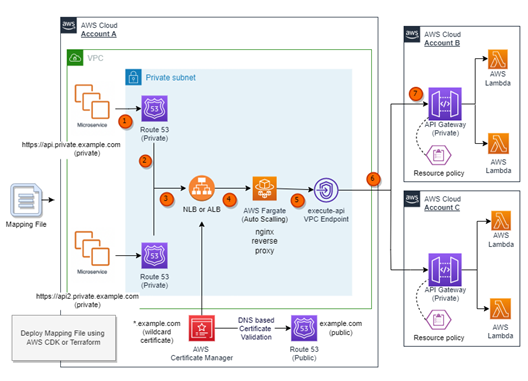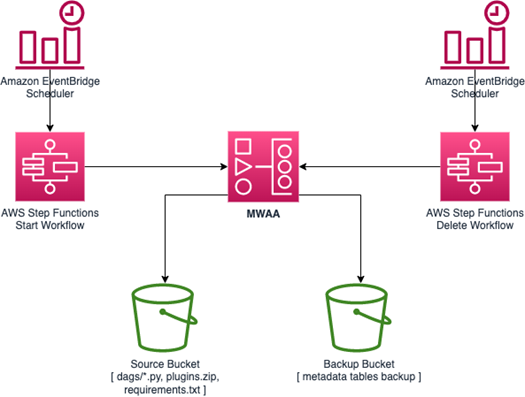AWS Compute Blog
Ruby 3.2 runtime now available in AWS Lambda
Get started building with Ruby 3.2 today by making necessary changes for compatibility with Ruby 3.2, and specifying a runtime parameter value of ruby3.2 when creating or updating your Lambda functions.
Implementing custom domain names for Amazon API Gateway private endpoints using a reverse proxy
This blog post demonstrates a solution that allows customers to utilize their private endpoints securely with API Gateway across AWS accounts and within a VPC network by using a reverse proxy with a custom domain name. The solution offers a simplified approach to manage the mapping between private endpoints with API Gateway and custom domain names, ensuring seamless connectivity and security.
Developing a serverless Slack app using AWS Step Functions and AWS Lambda
This blog was written by Sam Wilson, Cloud Application Architect and John Lopez, Cloud Application Architect. Slack, as an enterprise collaboration and communication service, presents opportunities for builders to improve efficiency through implementing custom-written Slack Applications (apps). One such opportunity is to expose existing AWS resources to your organization without your employees needing AWS Management […]
Reserving EC2 Capacity across Availability Zones by utilizing On Demand Capacity Reservations (ODCRs)
This post is written by Johan Hedlund, Senior Solutions Architect, Enterprise PUMA. Many customers have successfully migrated business critical legacy workloads to AWS, utilizing services such as Amazon Elastic Compute Cloud (Amazon EC2), Auto Scaling Groups (ASGs), as well as the use of Multiple Availability Zones (AZs), Regions for Business Continuity, and High Availability. These […]
Best practices to optimize your Amazon EC2 Spot Instances usage
This blog post is written by Pranaya Anshu, EC2 PMM, and Sid Ambatipudi, EC2 Compute GTM Specialist. Amazon EC2 Spot Instances are a powerful tool that thousands of customers use to optimize their compute costs. The National Football League (NFL) is an example of customer using Spot Instances, leveraging 4000 EC2 Spot Instances across more […]
Automating stopping and starting Amazon MWAA environments to reduce cost
This was written by Uma Ramadoss, Specialist Integration Services, and Chandan Rupakheti, Solutions Architect. This blog post shows how you can save cost by automating the stopping and starting of an Amazon Managed Workflows for Apache Airflow (Amazon MWAA) environment. It describes how you can retain the data stored in a metadata database and presents […]
Monitor Amazon SNS-based applications end-to-end with AWS X-Ray active tracing
This post is written by Daniel Lorch, Senior Consultant and David Mbonu, Senior Solutions Architect. Amazon Simple Notification Service (Amazon SNS), a messaging service that provides high-throughput, push-based, many-to-many messaging between distributed systems, microservices, and event-driven serverless applications, now supports active tracing with AWS X-Ray. With AWS X-Ray active tracing enabled for SNS, you can […]
Debugging SnapStart-enabled Lambda functions made easy with AWS X-Ray
This post is written by Rahul Popat (Senior Solutions Architect) and Aneel Murari (Senior Solutions Architect) Today, AWS X-Ray is announcing support for SnapStart-enabled AWS Lambda functions. Lambda SnapStart is a performance optimization that significantly improves the cold startup times for your functions. Announced at AWS re:Invent 2022, this feature delivers up to 10 times faster function startup times for […]
Implementing cross-account CI/CD with AWS SAM for container-based Lambda functions
Containerized applications often have several distinct environments and accounts, such as dev, test, and prod. An application has to go through a process of deployment and testing in these environments. One common pattern for deploying containerized applications is to have a central AWS create a single container image, and carry out deployment across other AWS accounts. To achieve automated deployment of the application across different environments, customers use CI/CD pipelines with familiar container tooling. This blog post explores how to use AWS Serverless Application Model (AWS SAM) Pipelines to create a CI/CD deployment pipeline and deploy a container-based Lambda function across multiple accounts.
AWS Nitro System gets independent affirmation of its confidential compute capabilities
Anthony Liguori is an AWS VP and Distinguished Engineer for EC2. Customers around the world trust AWS to keep their data safe, and keeping their workloads secure and confidential is foundational to how we operate. Since the inception of AWS, we have relentlessly innovated on security, privacy tools, and practices to meet, and even exceed, […]









